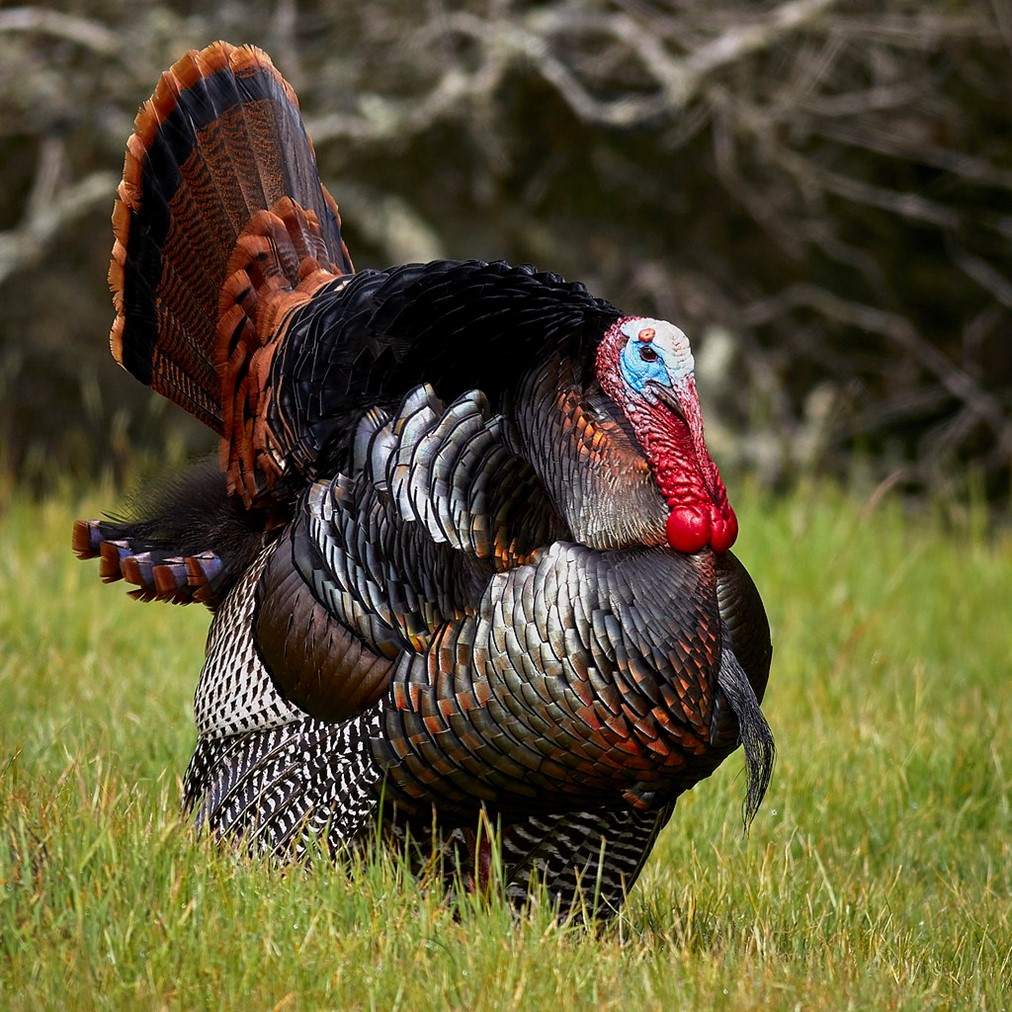
Credit: Frank Schulenburg, via Wikimedia Commons
As we know, birds descended from dinosaurs. And with 18,000 species of bird now living, there may be more “dinosaur” species today than ever before. The birds that share the most DNA with their dinosaur ancestors are, surprisingly, the chicken and the turkey.
The turkey, like the tyrannosaur, has a wishbone and a similar hip structure. And it has meaty drumsticks and thighs like a Velociraptor. Yum!
The turkey probably evolved from prehistoric birds in South America and migrated northward.
During the last Ice Age, the California turkey was a favorite food for humans, with bones found at cooking sites. That turkey went extinct 10,000 years ago, probably from overhunting and warming as the ice retreated.
Luckily, the Mexican turkey persevered. It was domesticated by the Maya, then the invading Spaniards, who took it back to Europe and on to England.
Because it was considered an exotic food, and many exotic foods came from the Ottoman Empire, it was called the Turkish cock, then simply, turkey.
From England, the domestic bird was exported back to North America. Meanwhile, the wild variety here had again been hunted nearly to extinction.
A reintroduction campaign has brought back the wild turkey. There are now 7 million in the US living free—while 45 million of their domesticated cousins are destined each year for the Thanksgiving table.
Background
Synopsis: The first Thanksgiving dinner occurred more than 400 years ago in Plymouth, Massachusetts. The traditional main course, turkey, has a fascinating story that goes back millions of years, with a couple of close calls!
- The first Thanksgiving dinner took place in 1621 in Plymouth, Massachusetts.
- Today Americans relive the event, feasting on turkey and accompaniments and giving thanks every fourth Thursday in November with friends and relatives.
- If you thought your relatives were scary, consider this, Tyrannosaurus rex and turkeys descended from a common ancestor. They are cousins, albeit many times removed.
- Birds are the only known dinosaur group living today, as we explained in ED-030 Dinosaurs in Your Backyard.
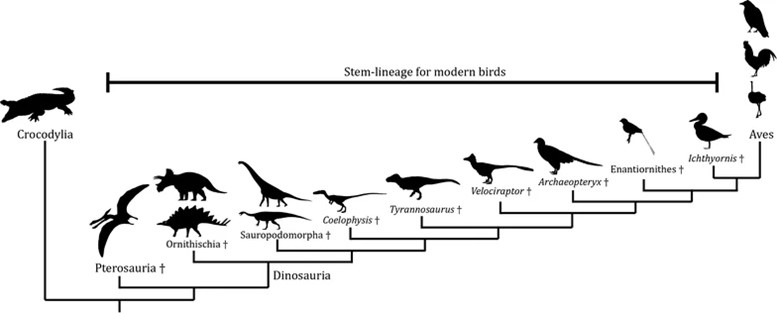
Simplified phylogenetic tree showing the sequenced relationship between birds and dinosaurs that took place over more than 200 million years.
Credit: Roy E. Plotnick, Jessica M. Theodor & Thomas R. Holtz Jr., via Wikimedia Commons - Birds evolved from two-legged dinosaurs known as therapods that first walked on Earth more than 200 million years ago in the Late Triassic Period.
- Jurassic coelurosaurs evolved from their carnivorous theropod relatives, becoming omnivores (meat, plant and seed eaters), and most were feathered for at least part of their life cycle.
- In the Late Cretaceous Period, about 70 million years ago, some coelurosaurs decreased in size and developed extended forelimbs that ultimately became wings, while others evolved into tyrannosaurs and Velociraptors.
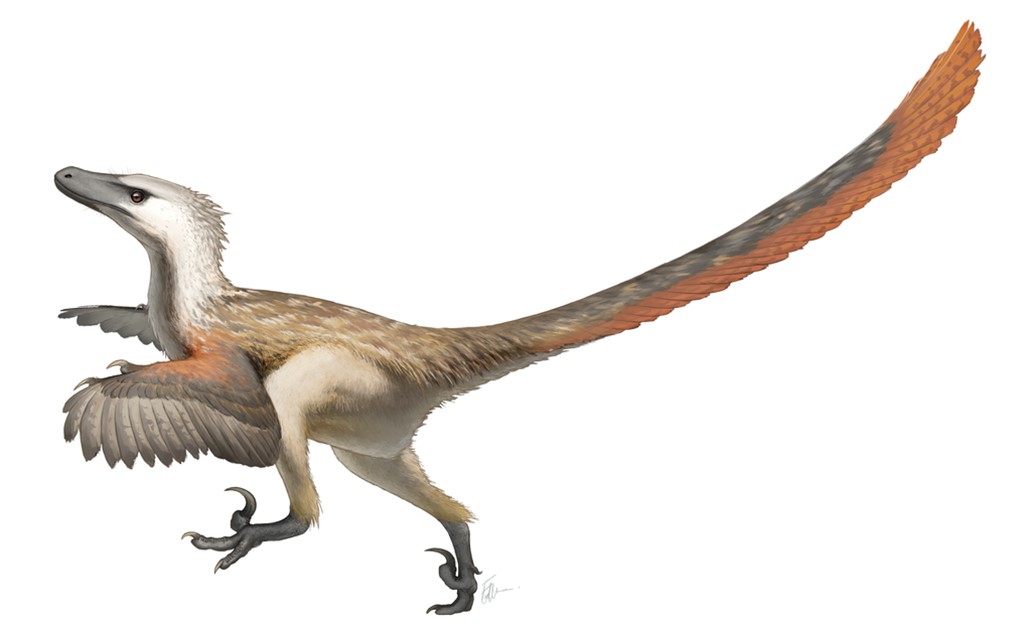
Velociraptor mongoliensis was a non-avian coelurosaur from China with short forelimbs compared to Aves (bird) forelimbs that eventually evolved into wings.
Credit: Fred Wierum, via Wikimedia Commons - Winged coelurosaurs were the only dinosaurs capable of flight. They are the avian dinosaurs that belong to the class Aves. Today we call them birds.
- Being omnivores probably enabled avian dinosaurs to survive the impact that killed the non-avian dinosaurs, ending the Mesozoic Era (ED-080 High-Impact Mystery). They could forage the ravaged forest floor for seeds that survived fires.
- A 2016 study by the American Museum of Natural History estimates today there are more than 18,000 bird species, which means that there may be more species of dinosaur alive today than during the Mesozoic Era.
- Birds are the only known dinosaur group living today, as we explained in ED-030 Dinosaurs in Your Backyard.
- The DNA of turkeys is closer to that of their ancestors than any other modern birds except chickens.
- Like turkeys, tyrannosaurs had a fused collarbone called a wishbone, or furcula. In turkeys (and prehistoric avian dinosaurs), the flexible V-shaped bone acts as a spring that works with the breast muscles to store and release energy during flight. For tyrannosaurs, the bone probably helped it to grip prey with its tiny arms.
- The tips of turkey wings are fleshed over, but the wingtip bone structure is where claws would have protruded from the arms of non-avian theropods such as Velociraptor and Bambiraptor.
- While early dinosaurs had forward-pointing hips, the hip structure of coelurosaurs evolved to point backward, so the hip structure of tyrannosaurs is similar to the hip structure of your holiday turkey.
- Turkey leg structure, made up of the drumsticks and thighs, is similar to the leg structure of theropods like Velociraptor that could probably run as fast as 40 mph (65 km/h). The top running speed for wild turkeys is about 25 mph (40 km/h).
- The ancestors of turkeys probably evolved from prehistoric birds in South America, migrating to Central America and western North America by about 11 million years ago in the Miocene Epoch. Turkeys are closely related to grouse and pheasants.
- Fast forward to the arrival of the first Americans, who found abundant food in western North America, including Meleagris californica, the California turkey.
- Abundant fossils of the California turkey from the Ice Age La Brea Tar Pits in Los Angeles indicate it had a shorter, wider beak than modern turkeys and was stockier.
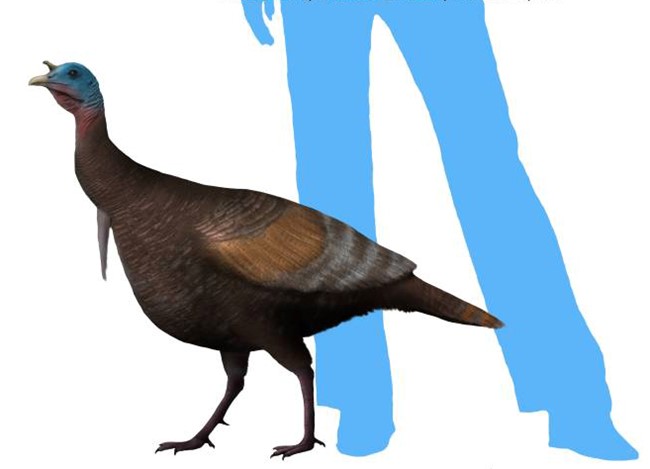
Restoration of Meleagris californica.
Credit: Nobu Tamura, via Wikimedia Commons - Turkey bones were common at prehistoric cooking sites.
- This prehistoric turkey went extinct about 10,000 years ago, probably from overhunting or the climate effects of the end of the Pleistocene glaciation.
- Luckily for us, another species of turkey evolved in Mexico—Meleagris gallopavo, the modern turkey, with five subspecies. Modern turkeys had a circuitous history.
- The southern Mexico subspecies Meleagris gallopavo gallopavo is the ancestor of today’s domesticated turkey Meleagris gallopavo domesticus.
- The Mayans domesticated the southern Mexico subspecies more than 2,000 years ago.
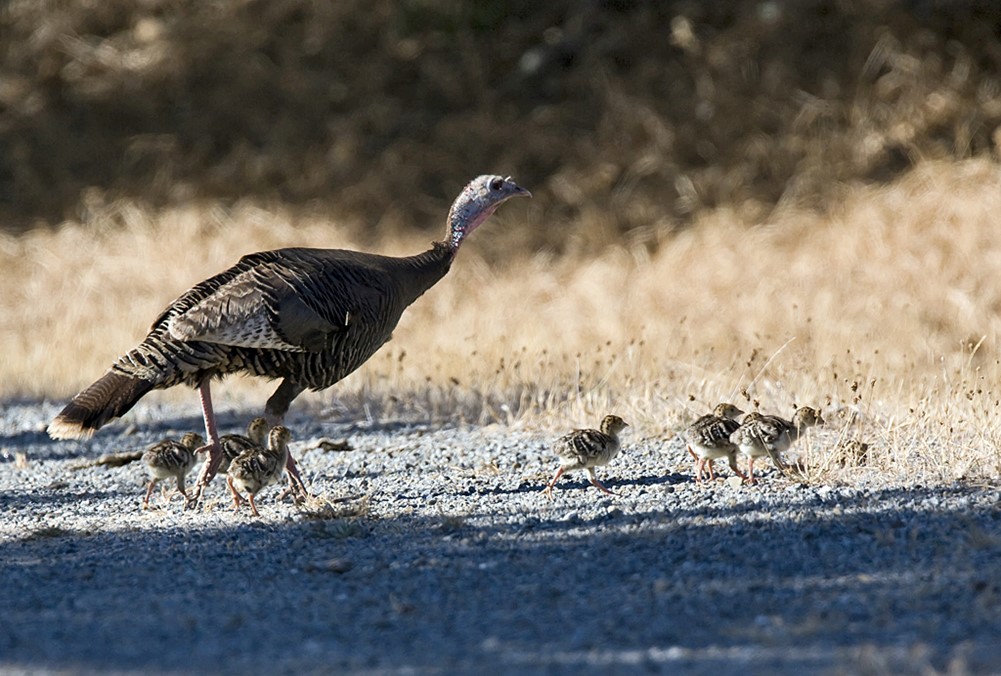
Wild female Turkey (Meleagris gallopavo) and eight chicks.
Credit: Kevin Cole from Pacific Coast, USA, via Wikimedia Commons - When Spanish explorers invaded Mexico, they exported the bird to Europe in 1519, where further domestication occurred, and then imported birds to England around 1541, where even more domestication occurred.
- Then, nearly a century after departing Mexico, the European varieties were reintroduced back into the New World. In 1608, the English shipped the birds to Jamestown, Virginia, and pilgrims introduced these European turkeys to New England in 1620, just in time for the first Thanksgiving in Plymouth, Massachusetts, in 1621.
- European settlers cleared habitat to build farms and hunted the birds nearly to extinction.
- Wild turkeys disappeared from Connecticut by 1813 and Vermont by 1842.
- By the early 1930’s, their population had dropped from 10 million to 200,000.
- With the Depression and World War II, restoration programs were postponed, but, when prosperity resumed, a successful repopulation program headed off a second extinction for turkeys in North America.
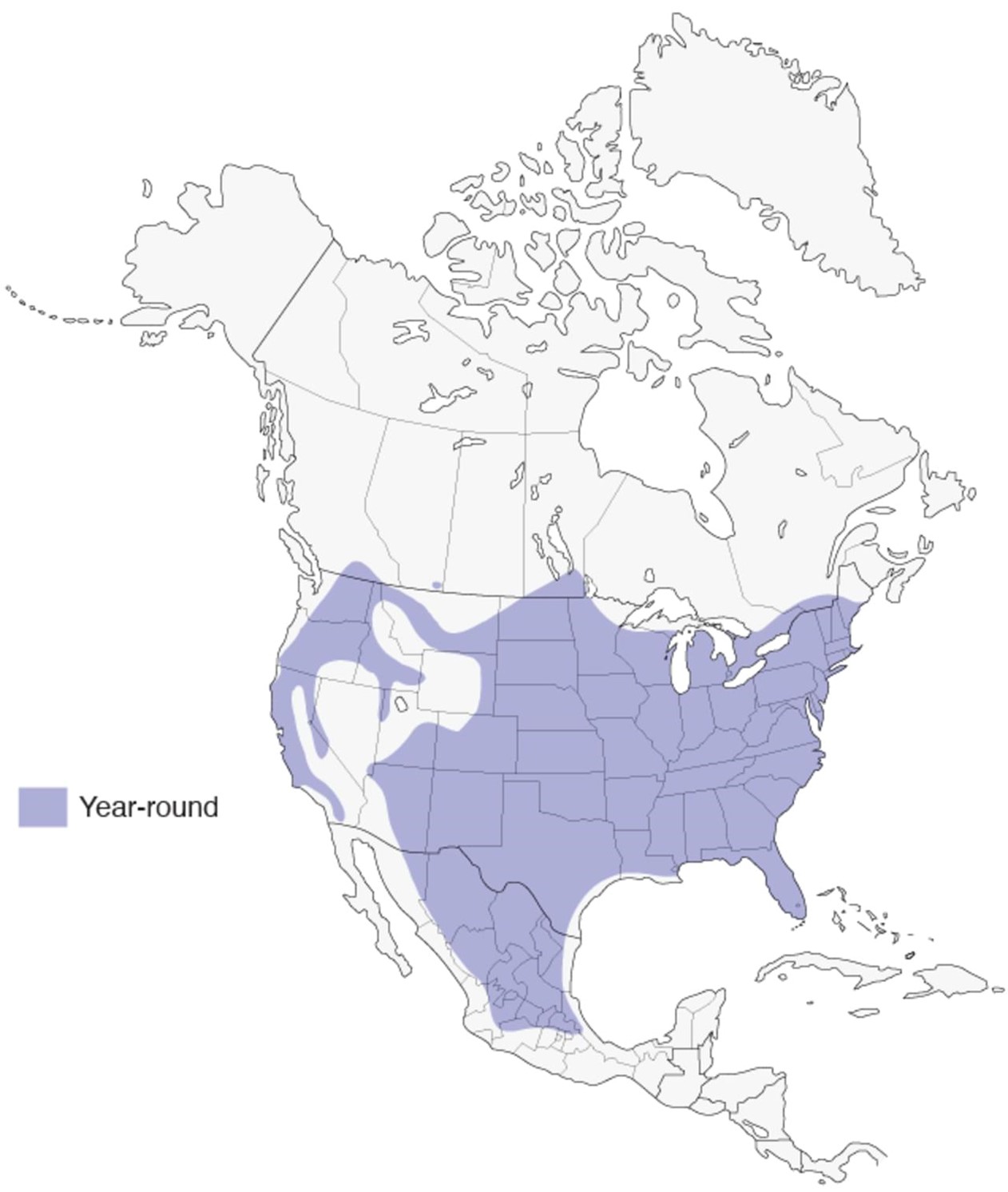
More than seven million wild turkeys live in North America today.
Credit: All About Birds
- The bird got the name turkey because it was exotic at a time when most exotic foods were being sourced from the Ottoman Empire in the country of Turkey.
- Corn or maize was known as “Turkish Wheat,” and Meleagris gallopavo were known as “Turkish cocks” despite the fact they both originated in the New World.
- Turkish cocks was shortened to turkey as the fowl grew in popularity.
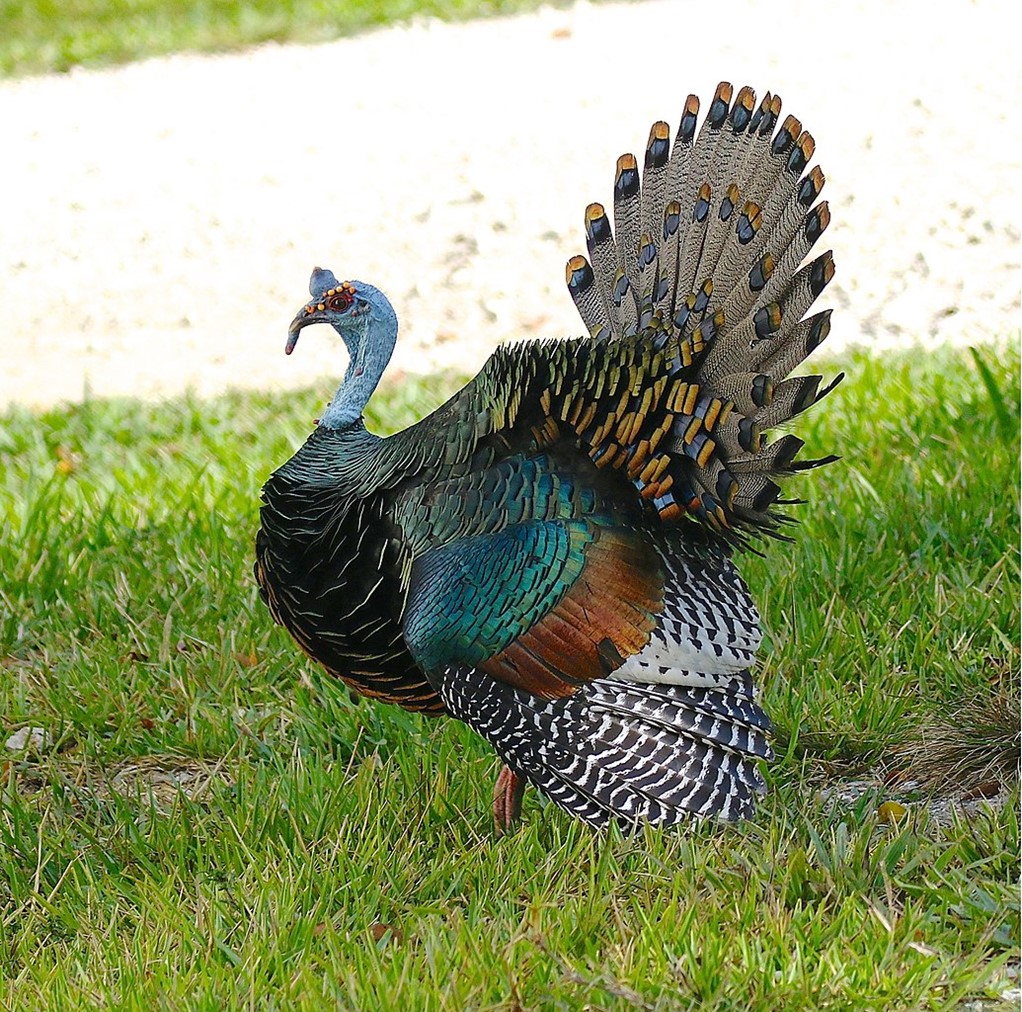
The ocellated turkey (Meleagris ocellata) is named for the eye-shaped spots (ocelli) on its tail feathers. The colors of this subspecies are brighter, almost fluorescent. The ocellated turkey's skin is bright blue with yellow or yellow-orange nodule-shaped wattles. The ocellated turkey is only found in the Yucatan Peninsula and the very northern parts of Belize and Guatemala.
Credit: TonyCastro, via Wikimedia Commons

